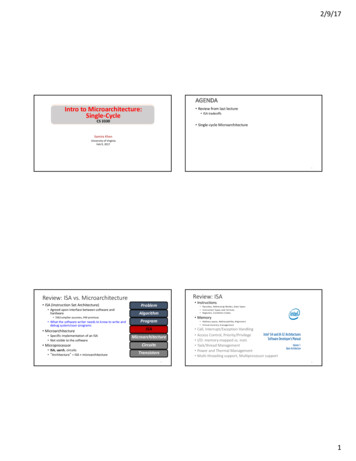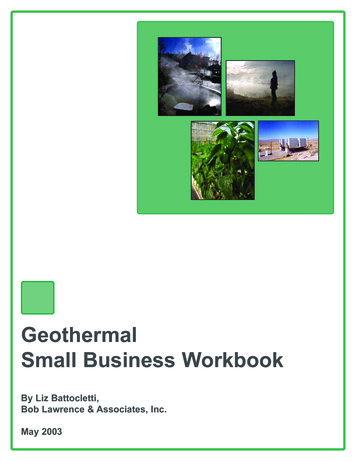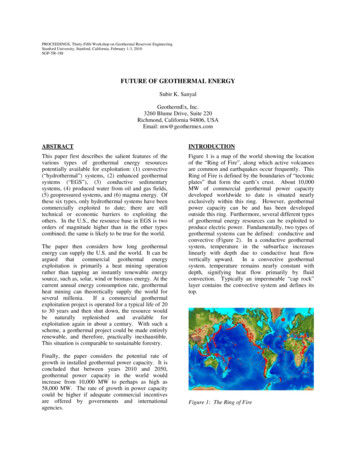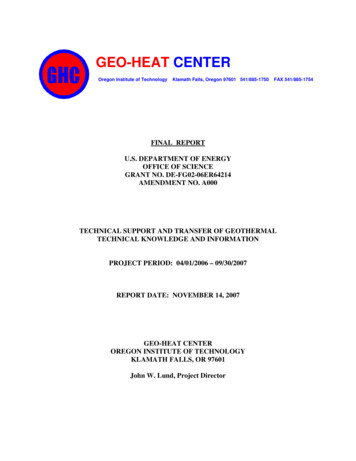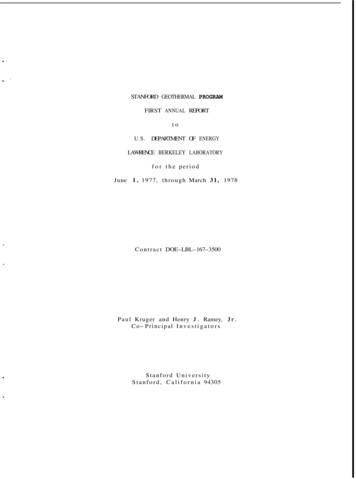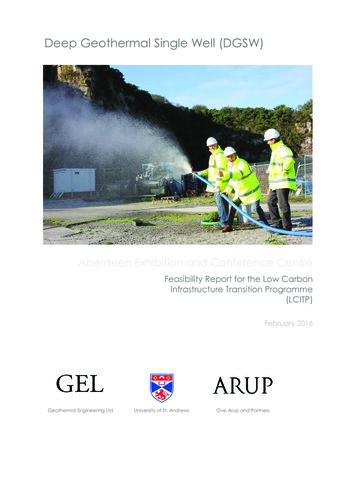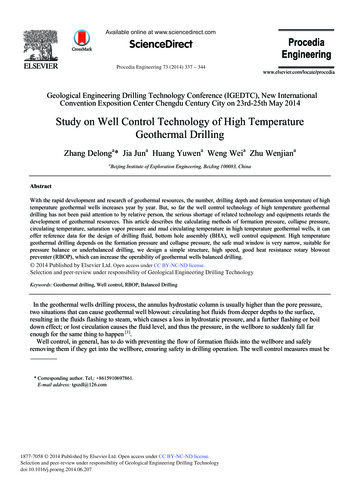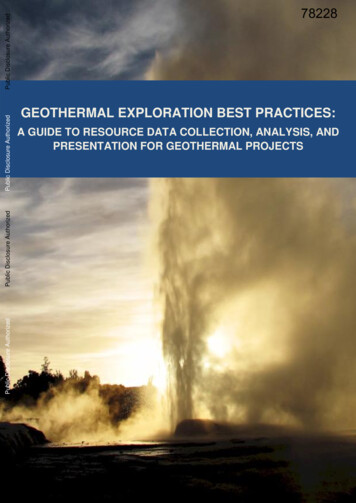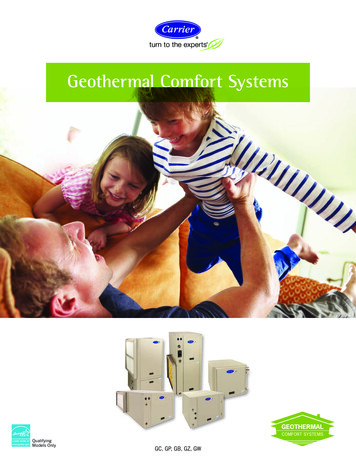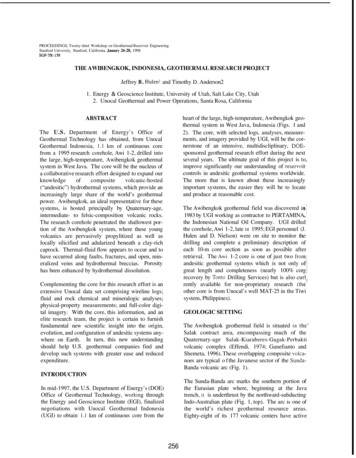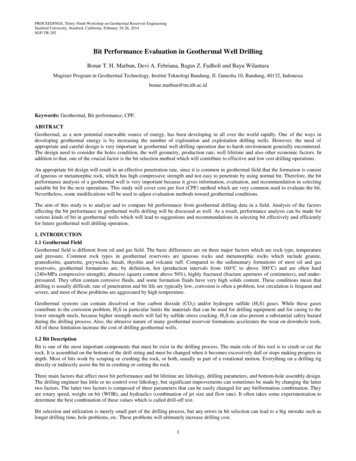
Transcription
PROCEEDINGS, Thirty-Ninth Workshop on Geothermal Reservoir EngineeringStanford University, Stanford, California, February 24-26, 2014SGP-TR-202Bit Performance Evaluation in Geothermal Well DrillingBonar T. H. Marbun, Devi A. Febriana, Bagus Z. Fadholi and Bayu WilantaraMagister Program in Geothermal Technology, Institut Teknologi Bandung, Jl. Ganesha 10, Bandung, 40132, Indonesiabonar.marbun@tm.itb.ac.idKeywords: Geothermal, Bit performance, CPF.ABSTRACTGeothermal, as a new potential renewable source of energy, has been developing in all over the world rapidly. One of the ways indeveloping geothermal energy is by increasing the number of exploration and exploitation drilling wells. However, the need ofappropriate and careful design is very important in geothermal well drilling operation due to harsh environment generally encountered.The design need to consider the holes condition, the well geometry, production rate, well lifetime and also other economic factors. Inaddition to that, one of the crucial factor is the bit selection method which will contribute to effective and low cost drilling operations.An appropriate bit design will result in an effective penetration rate, since it is common in geothermal field that the formation is consistof igneous or metamorphic rock, which has high compressive strength and not easy to penetrate by using normal bit. Therefore, the bitperformance analysis of a geothermal well is very important because it gives information, evaluation, and recommendation in selectingsuitable bit for the next operations. This study will cover cost per foot (CPF) method which are very common used to evaluate the bit.Nevertheless, some modifications will be used to adjust evaluation methods toward geothermal conditions.The aim of this study is to analyze and to compare bit performance from geothermal drilling data in a field. Analysis of the factorsaffecting the bit performance in geothermal wells drilling will be discussed as well. As a result, performance analysis can be made forvarious kinds of bit in geothermal wells which will lead to suggestions and recommendations in selecting bit effectively and efficientlyfor future geothermal well drilling operation.1. INTRODUCTION1.1 Geothermal FieldGeothermal field is different from oil and gas field. The basic differences are on three major factors which are rock type, temperatureand pressure. Common rock types in geothermal reservoirs are igneous rocks and metamorphic rocks which include granite,granodiorite, quartzite, greywacke, basalt, rhyolite and volcanic tuff. Compared to the sedimentary formations of most oil and gasreservoirs, geothermal formations are, by definition, hot (production intervals from 160 C to above 300 C) and are often hard(240 MPa compressive strength), abrasive (quartz content above 50%), highly fractured (fracture apertures of centimeters), and underpressured. They often contain corrosive fluids, and some formation fluids have very high solids content. These conditions mean thatdrilling is usually difficult, rate of penetration and bit life are typically low, corrosion is often a problem, lost circulation is frequent andsevere, and most of these problems are aggravated by high temperature.Geothermal systems can contain dissolved or free carbon dioxide (CO2) and/or hydrogen sulfide (H2S) gases. While these gasescontribute to the corrosion problem, H2S in particular limits the materials that can be used for drilling equipment and for casing to thelower strength steels, because higher strength steels will fail by sulfide stress cracking. H 2S can also present a substantial safety hazardduring the drilling process. Also, the abrasive nature of many geothermal reservoir formations accelerates the wear on downhole tools.All of these limitation increase the cost of drilling geothermal wells.1.2 Bit DescriptionBit is one of the most important components that must be exist in the drilling process. The main role of this tool is to crush or cut therock. It is assembled on the bottom of the drill string and must be changed when it becomes excessively dull or stops making progress indepth. Most of bits work by scraping or crushing the rock, or both, usually as part of a rotational motion. Everything on a drilling rigdirectly or indirectly assist the bit in crushing or cutting the rock.Three main factors that affect most bit performance and bit lifetime are lithology, drilling parameters, and bottom-hole assembly design.The drilling engineer has little or no control over lithology, but significant improvements can sometimes be made by changing the lattertwo factors. The latter two factors is composed of three parameters that can be easily changed for any bit/formation combination. Theyare rotary speed, weight on bit (WOB), and hydraulics (combination of jet size and flow rate). It often takes some experimentation todetermine the best combination of these values which is called drill-off test.Bit selection and utilization is merely small part of the drilling process, but any errors in bit selection can lead to a big mistake such aslonger drilling time, hole problems, etc. These problems will ultimately increase drilling cost.1
Marbun et al.1.3 Bit Evaluation MethodIn this study, evaluation of bit depends on provided drilling data. Highly complex drilling data is simplified to obtain a comparison Costper Foot (CPF) from each bit brand as linear function of engineering and cost. This simple model is not intended to compare overalldrilling cost, but to compare relative cost of bit brand that have been used in Indonesia by many drilling company at many fields.Several parameters for evaluation are bit cost, bit lifetime, rate of penetration, and operational cost. All of these parameters are dividedinto two zones with linear constraint. The purpose of this model is to analyze and to evaluate the efficiency of bit. Then, the evaluationis used for further optimization of brand selection and specification bit to improve the cost effectiveness of drilling.1.4 Bit Performance in GeothermalThe main problem of geothermal drilling is low penetration rate of bit because of high torque friction, which is caused by subsurfacecondition comprises of hard formation and high temperature affecting performance of bit. The performance of bit can be checked inhistory data usage of bit. By evaluating the data, bit performance analysis can be made. The bit performance analysis depends on severalvariables such as bit type, bit design, formation characteristics, bit durability and drilling condition. If bit is not used in accordance withthe subsurface condition and formation, it will lead to an escalation of bit cost and ineffectiveness in geothermal well drilling.2. METHODOLOGYIn the end of drilling process, sets of evaluations are required in order to make references for the next drilling process. One example ofthe evaluation is bit performance evaluation that will show the bit utilization evaluation in the drilling process. In general, one of themethods used for bit evaluation is Cost per Foot method. The method has been generally used in oil and gas field application. However,in this study, this method is applied for geothermal field. Because of that, the main idea of this study is to validate the CPF methodsuitability in geothermal field.2.1 Cost per FootCost per Foot (CPF) method is a common method that is carried out to determine the performance parameters of a bit in drillingoperation which include parameters such as the price of drilling bit, bit life, rate of penetration, equipment rental costs, operating timeand cumulative depth obtained.The formula applied in the method of Cost per Foot (CPF) is:()(1)The basic assumption used in this method is that the difficulties in a particular well’s section compare to other well’s section in the samefield remain the same. However, in practice, the Cost per Foot method still has several drawbacks. The drawbacks may come fromdifferent conditions experienced by the bit in the formation being penetrated. Thus, in an effort to analyze the performance of a bitrelative to other types of bit, their conditions must first be adjusted. In other words, corrections will be necessary to this method whenapplied for the bit performance analysis.The condition that must be obtained in the bit performance comparison is that the use of cost per foot method must be in a balancedcomparison. It means that in comparing the bits performance, these bits must be in the same and balanced condition. It is importantbecause it is the correct way to check the optimum performance given by each bit in the term of cost and technical parameters.For geothermal conditions, there are also some corrections made before this method applied. The basic equation is:(2)Time parameter divided into three types:(3)Constant cost divided into two types: (4)Then, the interval cost become:() (5)In order to make a new bit compete with old bit economically, interval cost new bit must be less or the same with the old bit cost.() ()2 (6)
Marbun et al.The assumptions applied in this method are:a.b.c.d.The time and cost of end-of-interval does not change with a new bit ,The costs of methods do not change,The daily cost do not changed,Drilling time is greater than tripping time and bottom hole assembly (BHA) ( ).With the assumption above, the equations become:()()(7)The relationship between the number of bits and the drilling time is as follows:(8)(9)Therefore, the condition of new bit, which can compete with the old bit economically, is as 15)}(16)Inequality linear relationship passes through the point (0, 1) on the dimensionless variablesand(Figure 1). This line divides the space into two operational areas. The region above the line is cost effective area for the newtechnologies and region below the line indicates the cost-ineffective area.Figure 1: Inequality relationship to evaluate cost-effective bit3
Marbun et al.3. FIELD STUDYIn this study, several field data have been prepared regarding bit performance evaluation. The data reviewed is obtained fromgeothermal field “L” in Indonesia. The field is located in a volcanic depression which has an area of 12 km2. The depression issurrounded by complex volcanic chain system creating an immense potential source of geothermal energy.The geothermal field “L” is counted as productive field in Indonesia and still in the process of further development. In its development,geothermal field “L” already has several wells consist of injection and production wells.3.1 Rock CharacteristicsJudging from the characteristics of the reservoir rock, as mentioned previously, geothermal reservoir is often consist of igneous ormetamorphic rock which is harder than sandstone or limestone in a normal oil and gas field. The statement is also valid for reservoircharacteristic in geothermal field “L”.Regionally, rock distribution in this area is dominated by young volcanoes rock formation consist of lava, bomb, lapilli and ash fromquarter age. Tufa formation which is consist of coarse clastic volcano mainly composed of andesite, composed of angular componentand semi-angular component identified as many limestone fraction, lapilli pumice, breccia, dense ignimbrite from quarter age. The rockformation of geothermal field “L” consists of breccia, lava and tuff from Miocene age.In addition to the conditions mentioned above, faults condition which is exist in geothermal field “L” are also well identified. Fromgeological and geophysical data, these faults are identified as normal faults with slope or inclination near to vertical.3.2 Bit Evaluation MethodThe data is obtained from several adjacent wells of geothermal field “L” with relatively same formation being penetrated. Using thecorrected CPF method above, the data is tabulated and the bit performance is compared for each section wells drilled and for each brandof bits used in the drilling process.3.3 Bit Performance Result3.3.1 Well Section 26”:The lowest CPF comes from bit with brand “V” with the value of US 363. The highest CPF also comes from the same brand with thevalue of US 2939. The differences of CPF value between bit brand “V” and bit brand “S” is relatively not too far.Cost per interval (US /m)35003000Well Section 26"293625002000150011361000500979 904 875434 466 516363600 562 6760VSSVVVSSSSVVBit BrandFigure 2: Bit Performance Result Well Section 26"3.3.2 Well Section 17 1/2”:The lowest CPF comes from bit with brand “S” with the value of US 408. The highest CPF comes from bit with brand “V” with thevalue of US 2295.The broad distinction of CPF value of bit brand “V” in each well shows that there are other drilling variables affecting CPF other thanvariable in CPF equation mentioned above. Further analysis and evaluation is required in drilling design and operational in well section17 1/2” of geothermal field “L”.Bit brand “R” has CPF value that is relatively close to the bit brand “S”.4
Marbun et al.Cost per interval (US /m)2500Well Section 17 1/2"200015002295171412001022100895610005001020 1066921780720703 613696534484480432 425 408620 6170VVVVVVSSSRSSVRVVVSVVVVBit BrandFigure 3: Bit Performance Result Well Section 17 1/2"3.3.3 Well Section 12 1/4”:The lowest CPF comes from bit with brand “V” with the value of US 274. The highest CPF also comes the same brand with the valueof US 1148.The broad distinction of CPF value of bit brand “V” in each well shows that there are other drilling variables affecting CPF other thanvariable in CPF equation mentioned above. Further analysis and evaluation is required in drilling design and operational in well section12 1/4” of geothermal field “L”.Cost per interval (US /m)1400114899612001000Well Section 12 1/4"877800790722664677517 549 5416004001075286274379340 360 347326 3102852000VVVRHHVVRVVVVRRRVVVVBit BrandFigure 4: Bit Performance Result Well Section 12 1/4"3.3.4 Well Section 9 7/8”:The lowest CPF comes from bit with brand “V” with the value of US 197. The highest CPF also comes from the same brand with thevalue of US 892.The broad distinction of CPF value of bit brand “V” in each well shows that there are other drilling variables affecting CPF other thanvariable in CPF equation mentioned above. Further analysis and evaluation is required in drilling design and operational in well section9 7/8” of geothermal field “L”.In this section, there is no other brand of bit used in the drilling process, thereby; comparison among the bit brand cannot be done.5
Cost per interval (US /m)Marbun et al.700485500Well Section 9 00VVVVVVVVVBit BrandFigure 5: Bit Performance Result Well Section 9 7/8"3.3.5 Well Section 8 1/2”:The lowest CPF comes from bit with brand “V” with the value of US 191. The highest CPF also comes from the same brand with thevalue of US 816.The broad distinction of CPF value of bit brand “V” in each well shows that there are other drilling variables affecting CPF other thanvariable in CPF equation mentioned above. Further analysis and evaluation is required in drilling design and operational in well section8 1/2” of geothermal field “L”.Cost per interval (US /m)In this section, there is no other brand of bit used in the drilling process, thereby; comparison among the bit brand can’t be done.9008007006005004003002001000816782Well Section 8 1/2"655267191VVVVVBit BrandFigure 6: Bit Performance Result Well Section 8 1/2"4. CONCLUSION1. In this study, the bits have been evaluated in each section wells in that mentioned Field.2. The concept of Cost per Foot (CPF), to evaluate various brands of bits, is a linear function of engineering and cost parameters.The parameters used are bit cost, bit lifespan, rate of penetration, and operational cost.3. In this study, the data which have been evaluated are merely drilling operational data from wells in a field which has relativelysimilar level of difficulty and non-productive time.4. Highly extreme drilling data, such as when the incidence of pipe sticking happened, non- productive time is very high, etc., arenot used.5. CPF calculation method in this study is relative. Therefore, CPF calculation results in this study shows that the conclusionnumber 3 should be considered more critical.6
Marbun et al.6. The results of calculation and evaluation are shown below.Field“L”Section (“)The most effective bit brand26V17 ½S12 ¼V9 7/8V8½V7. By simply referring to the calculation of the value of CPF sorted from the smallest to the largest, bit selection for each section ineach field can be done.8. To obtain the results of the calculation and analysis more precise, it takes a more in-depth analysis and evaluation. The flowdiagram below describes the parameters of what is not in the CPF calculation but greatly affect the value of CPF. This flowdiagram (Figure 7) shows that the effectiveness of a bit is strongly influenced by other parameters, such as mud design, drillstring and BHA design, and others.9. Data collection and reporting system of the drilling operation can be made better in the future so that the analysis and evaluationof the tool can be done in an integrated and comprehensive, not only as a function of the economic effectiveness of the drilling,but also as a function of engineering effectiveness of casing, mud, drill string and BHA, etc.Figure 7: Well Program, Adams (1985)NOMENCLATURECPF Cost per Foot ( /ft)CB Bit cost ( )CR Rig cost ( )tt Tripping time (hour)tr Rotating time (hour)F Footage (feet)Ct Interval costCD Daily operating costt Time for drilling and completion in some intervalCF Cost depend on time (remain constant)tD Drilling timetT Tripping time and BHAtE Other time (especially end-of-interval)CTi Method costNTi Number of method7
Marbun et al.CE Ll tbK Other constant cost (especially end-of-interval)Length of drilling intervalLifetime of bit type KREFERENCESAdams, N.J.: Drilling Engineering a Complete Well Planning Approach, PennWell Publishing Company, Tulsa, Oklahoma, (1985).Ebrahimi, M., and Noveiri, E.: Cost-Per-Foot Reduction by Bit-Run Optimization: A Simulation Study, SPE 133429, ACECRProduction Technology Research Institute, (2010).Finger, J., and Blankenship, D.: Handbook of Best Practices for Geothermal Drilling, Sandia National Laboratory, New Mexico,Albuquerque, (2010).Marbun, B., Aristya, R., Pinem, R., Ramli, B., and Gadi, K.B.: Evaluation of Non Productive Time of Geothermal Drilling Operations –Case Study in Indonesia, Proceedings Thirty-Eighth Workshop on Geothermal Reservoir Engineering, (2013).Marbun, B., Zulkhifly, S., Hariz, I., and Khairina, D.: Geothermal Drilling – An Overview, Proceedings IPA Thirty-Fifth AnnualConvention and Exhibition, (2011).Marbun, B., Zulkhifly, S., Priatmojo, S., and Gunawan, T.: Selection of Best Drilling Design for Geothermal Drilling – Case Studies,Proceedings IPA Thirty-Sixth Annual Convention and Exhibition, (2012).Marbun, B., and Zulkhifly, S.: Geothermal Well Integrity, Proceeding 11 th Annual Meeting and Conference, Indonesia GeothermalAssociation, Lampung, December 12-15th, (2011).Marbun, B., Ekasari N., and Asri, M.: Bit Performance Evaluation: A Case Study in “X” Geothermal Field in Indonesia, Proceedings 2ndITB Geothermal Workshop, Bandung, March 4-8th, (2013).Rabia, H.: Specific Energy as a Criterion for Bit Selection, SPE 12355, University of Newcastle, England, Newcastle, (1985).Varnado, S. G., Huff, C. F., and Yarrington, P.: The Design and Use of Polycristalline Diamond Compact Drag Bits in The GeothermalEnvironment*, SPE 8378, Sandia Laboratories, (1979).ZhaoFeng, Z., Njee, J., Min, H., ZhengMing, S., Min, Z., and FaSheng, S.: Successful Implementation of HT Geothermal DrillingTechnology in Kenya, SPE 155831, CNPC Greatwall Drilling Company, (2012).8
affecting the bit performance in geothermal wells drilling will be discussed as well. As a result, performance analysis can be made for various kinds of bit in geothermal wells which will lead to suggestions and recommendations in selecting bit effectively and efficiently for future geothermal well drilling operation. 1. INTRODUCTION
